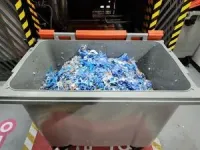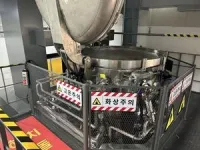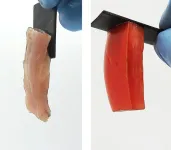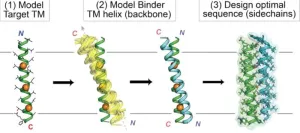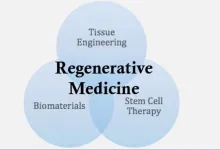(Press-News.org) A medical waste treatment system, which is capable of 99.9999 percent sterilization by using high-temperature and high-pressure steam, has been developed for the first time in the country.
The Korea Institute of Machinery and Materials (President Seog-Hyeon Ryu, hereinafter referred to as KIMM), an institute under the jurisdiction of the Ministry of Science and ICT, has succeeded in developing an on-site-disposal type medical waste sterilization system that can help to resolve the problem caused by medical waste, which has become a national and social issue as the volume of medical waste continues to increase every year. This project was launched as a basic business support program of the KIMM and was expanded into a demonstration project of Daejeon Metropolitan City. Then, in collaboration with VITALS Co., Ltd., a technology transfer corporation, the medical waste treatment system was developed as a finished product capable of processing more than 100 kilograms of medical waste per hour, and was demonstrated at the Chungnam National University Hospital.
Moreover, the installation and use of this product have been approved by the Geumgang Basin Environmental Office of the Ministry of Environment. All certification-related work for the installation and operation of this product at the Chungnam National University Hospital has been completed, including the passage of an installation test for efficiency and stability conducted by the Korea Testing Laboratory.
Through collaboration with VITALS Co., Ltd., a corporation specializing in inhalation toxicity systems, the research team led by Principal Researcher Bangwoo Han of the Department of Urban Environment Research of the KIMM’s Eco-Friendly Energy Research Division developed a high-temperature, high-pressure steam sterilization-type medical waste treatment system by using a high-temperature antimicrobial technology capable of processing biologically hazardous substances such as virus and bacteria with high efficiency. After pulverizing medical waste into small pieces so that high-temperature steam can penetrate deep into the interior of the medical waste, steam was then compressed in order to raise the boiling point of the saturated steam to over 100 degrees Celsius, thereby further improving the sterilization effect of the steam.
Meanwhile, in the case of the high-pressure steam sterilization method, it is vitally important to allow the airtight, high-temperature and high-pressure steam to penetrate deep into the medical waste. Therefore, the research team aimed to improve the sterilization effect of medical waste by increasing the contact efficiency between the pulverized medical waste and the aerosolized steam.
By using this technology, the research team succeeded in processing medical waste at a temperature of 138 degrees Celsius for 10 minutes or at 145 degrees Celsius for more than five (5) minutes, which is the world’s highest level. By doing so, the research team achieved a sterilization performance of 99.9999 percent targeting biological indicator bacteria at five (5) different locations within the sterilization chamber. This technology received certification as an NET (New Excellent Technology) in 2023.
Until now, medical waste has been sterilized by heating the exposed moisture using microwaves. However, this method requires caution because workers are likely to be exposed to electromagnetic waves and the entrance of foreign substances such as metals may lead to accidents.
In Korea, medical waste is mostly processed at exclusive medical waste incinerators and must be discharged in strict isolation from general waste. Hence, professional efforts are required to prevent the risk of infection during the transportation and incineration of medical waste, which requires a loss of cost and manpower.
If medical waste is processed directly at hospitals and converted into general waste by applying the newly developed technology, this can help to eliminate the risk of infection during the loading and transportation processes and significantly reduce waste disposal costs. By processing 30 percent of medical waste generated annually, hospitals can save costs worth KRW 71.8 billion. Moreover, it can significantly contribute to the ESG (environmental, social, and governance) management of hospitals by reducing the amount of incinerated waste and shortening the transportation distance of medical waste.
[*Allbaro System (statistical data from 2021): Unit cost of treatment for each type of waste for the calculation of performance guarantee insurance money for abandoned wastes (Ministry of Environment Public Notification No. 2021-259, amended on December 3, 2021). Amount of medical waste generated on an annual basis: 217,915 tons; Medical waste: KRW 1,397 per ton; General waste from business sites subject to incineration: KRW 299 per ton]
As the size and structure of the installation space varies for each hospital, installing a standardized commercial equipment can be a challenge. However, during the demonstration process at the Chungnam National University Hospital, the new system was developed in a way that allows the size and arrangement thereof to be easily adjusted depending on the installation site. Therefore, it can be highly advantageous in terms of on-site applicability.
Principal Researcher Bangwoo Han of the KIMM was quoted as saying, “The high-temperature, high-pressure steam sterilization technology for medical waste involves the eradication of almost all infectious bacteria in a completely sealed environment. Therefore, close cooperation with participating companies that have the capacity to develop airtight chamber technology is very important in materializing this technology.” He added, “We will make all-out efforts to expand this technology to the sterilization treatment of infected animal carcasses in the future.”
President Seog-Hyeon Ryu of the KIMM was quoted as saying, “The latest research outcome is significantly meaningful in that it shows the important role played by government-contributed research institutes in resolving national challenges. The latest technology, which has been developed through the KIMM’s business support program, has been expanded to a demonstration project through cooperation among the industry, academia, research institutes, and the government of Daejeon Metropolitan City.” President Ryu added, “We will continue to proactively support these regional projects and strive to develop technologies that contribute to the health and safety of the public.”
Meanwhile, this research was conducted with the support of the project for the “development of ultra-high performance infectious waste treatment system capable of eliminating 99.9999 percent of viruses in response to the post-coronavirus era,” one of the basic business support programs of the KIMM, as well as the project for the “demonstration and development of a safety design convergence-type high-pressure steam sterilization system for on-site treatment of medical waste,” part of Daejeon Metropolitan City’s “Daejeon-type New Convergence Industry Creation Special Zone Technology Demonstration Project.”
###
The Korea Institute of Machinery and Materials (KIMM) is a non-profit government-funded research institute under the Ministry of Science and ICT. Since its foundation in 1976, KIMM is contributing to economic growth of the nation by performing R&D on key technologies in machinery and materials, conducting reliability test evaluation, and commercializing the developed products and technologies.
This research was conducted with the support of the project for the “development of ultra-high performance infectious waste treatment system capable of eliminating 99.9999 percent of viruses in response to the post-coronavirus era,” one of the basic business support programs of the KIMM, as well as the project for the “demonstration and development of a safety design convergence-type high-pressure steam sterilization system for on-site treatment of medical waste,” part of Daejeon Metropolitan City’s “Daejeon-type New Convergence Industry Creation Special Zone Technology Demonstration Project.”
END
KIMM finds solution to medical waste problem, which has become a major national issue
Through business support program, KIMM develops medical waste sterilization technology that can be applied to hospitals.
2024-03-13
ELSE PRESS RELEASES FROM THIS DATE:
UNIST researchers uncover revolutionary phenomenon in liquid crystals
2024-03-13
A research team, affiliated with UNIST, has unveiled for the first time a new principle of motion in the microworld, where objects can move in a directed manner simply by changing their sizes periodically within a substance known as liquid crystal. Led by Professor Jonwoo Jeong and his research team in the Department of Physics at UNIST, this discovery is poised to have far-reaching implications across various research fields, including the potential development of miniature robots in the future.
In their research, the team observed that air bubbles within ...
Study tracks shifts in student mental health during college
2024-03-13
A four-year study by Dartmouth researchers captures the most in-depth data yet on how college students' self-esteem and mental health fluctuates during their four years in academia, identifying key populations and stressors that the researchers say administrators could target to improve student well-being.
The study also provides among the first real-time accounts of how the coronavirus pandemic affected students' behavior and mental health. The stress and uncertainty of COVID-19 resulted in long-lasting behavioral changes that persisted as a "new normal" even as the pandemic diminished, including feeling more stressed, less socially engaged, and sleeping more.
The ...
Recreational activities such as golfing, gardening may be associated with increased ALS risk among men
2024-03-13
Participation in recreational activities — including golfing, gardening or yard work, woodworking and hunting — may be associated with an increase in a person’s risk for developing amyotrophic lateral sclerosis, or ALS, a Michigan Medicine study finds.
While many activities were associated with increased ALS risk, several were sex specific. The results are published in the Journal of the Neurological Sciences.
“We know that occupational risk factors, like working in manufacturing and trade industries, are linked to an increased risk for ALS, and this adds to a growing literature that recreational activities may also represent ...
You don’t need glue to hold these materials together — just electricity
2024-03-13
Is there a way to stick hard and soft materials together without any tape, glue or epoxy? A new study published in ACS Central Science shows that applying a small voltage to certain objects forms chemical bonds that securely link the objects together. Reversing the direction of electron flow easily separates the two materials. This electroadhesion effect could help create biohybrid robots, improve biomedical implants and enable new battery technologies.
When an adhesive is used to attach two things, it binds the surfaces either through mechanical or electrostatic forces. But sometimes those attractions or bonds are difficult, if not ...
Heart disease risk factors of modern lifestyles threaten extremely poor people living in low- and middle-income countries
2024-03-13
A new study reveals that many people living in extreme poverty in low- and middle-income countries (LMICs) have conditions that lead to heart disease, the world’s #1 cause of death — overturning ‘conventional wisdom’.
In the largest analysis of its kind exploring the relationship between poverty and cardiovascular disease (CVD) risk factors, experts discovered a high prevalence of hypertension, diabetes, smoking, obesity, and dyslipidemia in LMICs regardless of income —yet most adults living in extreme poverty were not treated for these CVD-related conditions.
An international group of researchers note that their findings, ...
Air quality in Europe shows significant improvements over the last two decades, study finds
2024-03-13
A study led by the Barcelona Institute for Global Health (ISGlobal), a centre supported by the "la Caixa" Foundation, and the Barcelona Supercomputing Center - Centro Nacional de Supercomputación (BSC-CNS), has consistently estimated daily ambient concentrations of PM2.5, PM10, NO2 and O3 across a large ensemble of European regions between 2003 and 2019 based on machine learning techniques. The aim was to assess the occurrence of days exceeding the 2021 guidelines of the World Health Organization (WHO) for one or multiple pollutants, referred to as “unclean air days”.
The ...
Multiple air pollutants linked to asthma symptoms in children
2024-03-13
SPOKANE, Wash. – Exposure to several combinations of toxic atmospheric pollutants may be triggering asthma symptoms among children, a recent analysis suggests.
The study, published in the journal Science of the Total Environment, showed that 25 different combinations of air pollutants were associated with asthma symptoms among 269 elementary school children diagnosed with asthma in Spokane, Washington. In line with previous research, the Washington State University-led study revealed a socioeconomic disparity—with one group of children from a lower-income neighborhood exposed to more toxic combinations, a total of 13 of the 25 ...
New computational strategy boosts the ability of drug designers to target proteins inside the membrane
2024-03-13
LA JOLLA, CA—Hitting targets embedded within the cell membrane has long been difficult for drug developers due to the membrane’s challenging biochemical properties. Now, Scripps Research chemists have demonstrated new custom-designed proteins that can efficiently reach these “intramembrane” targets.
In their study, published March 13, 2024, in Nature Chemical Biology, the researchers used a unique computer-based approach to design novel proteins targeting the membrane-spanning region of the erythropoietin (EPO) receptor, which controls red blood cell production and can go awry in cancers. In addition ...
Genetic condition haemochromatosis linked to higher levels of disease in older people
2024-03-13
A largescale new study has found that some people whose genetics are linked to the common iron overload condition haemochromatosis have substantially greater levels of liver, musculoskeletal and brain disease than previously reported, especially at older ages.
Haemochromatosis causes a build-up of iron in the body which can cause harm to joints and organs – although the extent of this harm is unclear, especially in older ages. The new research, led by a team at the University of Exeter and supported by the National Institute for Health and Care ...
Advancing tissue engineering with shape memory hydrogels
2024-03-13
One of the primary goals in the field of tissue engineering and regenerative medicine is the development of artificial scaffolds that can serve as substitutes for damaged tissue. These materials must ideally resemble natural tissue and must have the ability to support cell adhesion, proliferation, and differentiation. When considering scaffold materials, researchers account for the scaffold’s properties, such as its surface roughness, its water content (hydration state), and its flexibility or stiffness (elastic modulus), since these properties are known to affect cell ...
LAST 30 PRESS RELEASES:
Study showcases resilience and rapid growth of “living rocks”
Naval Research Lab diver earns Office of Naval Research 2025 Sailor of the Year
New Mayo-led study establishes practical definition for rapidly progressive dementia
Fossil fuel industry’s “climate false solutions” reinforce its power and aggravate environmental injustice
Researchers reveal bias in a widely used measure of algorithm performance
Alcohol causes cancer. A study from IOCB Prague confirms damage to DNA and shows how cells defend against it
Hidden viruses in wastewater treatment may shape public health risks, study finds
Unlock the power of nature: how biomass can transform climate mitigation
Biochar reshapes hidden soil microbes that capture carbon dioxide in farmland
Reducing saturated fat intake shows mortality benefit, but only in high-risk individuals
Manta rays create mobile ecosystems, study finds
Study: Mixed results in using lipoic acid to treat progressive multiple sclerosis
Norbert Holtkamp appointed director of Fermi National Accelerator Laboratory
New agentic AI platform accelerates advanced optics design
Biologists discover neurons use physical signals — not electricity — to stabilize communication
Researchers discover that a hormone can access the brain by hitchhiking
University of Oklahoma researcher awarded funding to pursue AI-powered material design
Exploring how the visual system recovers following injury
Support for parents with infants at pediatric check-ups leads to better reading and math skills in elementary school
Kids’ behavioral health is a growing share of family health costs
Day & night: Cancer disrupts the brain’s natural rhythm
COVID-19 vaccination significantly reduces risk to pregnant women and baby
The role of vaccination in maternal and perinatal outcomes associated with COVID-19 in pregnancy
Mayo Clinic smartwatch system helps parents shorten and defuse children's severe tantrums early
Behavioral health spending spikes to 40% of all children’s health expenditures, nearly doubling in a decade
Digital cognitive behavioral treatment for generalized anxiety disorder
Expenditures for pediatric behavioral health care over time and estimated family financial burden
Air conditioning in nursing homes and mortality during extreme heat
The Alps to lose a record number of glaciers in the next decade
What makes a good proton conductor?
[Press-News.org] KIMM finds solution to medical waste problem, which has become a major national issueThrough business support program, KIMM develops medical waste sterilization technology that can be applied to hospitals.

